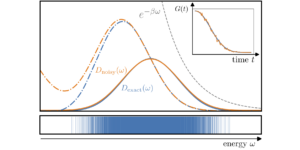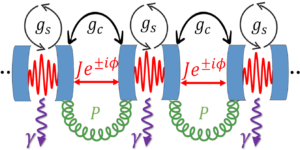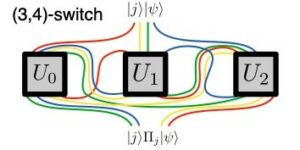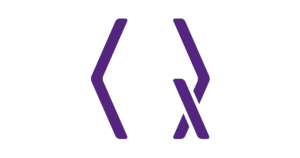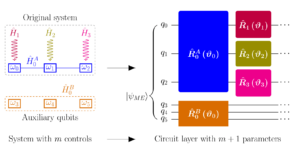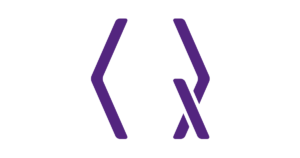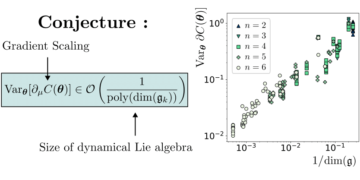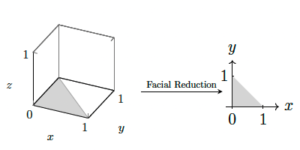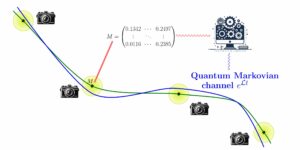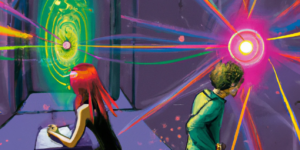11 JILA and Department of Physics, University of Colorado, Boulder, Colorado 80309, USA
2Department of Physics, Virginia Tech, Blacksburg, Virginia 24061, USA
Find this paper interesting or want to discuss? Scite or leave a comment on SciRate.
Abstract
By encoding logical qubits into specific types of photonic graph states, one can realize quantum repeaters that enable fast entanglement distribution rates approaching classical communication. However, the generation of these photonic graph states requires a formidable resource overhead using traditional approaches based on linear optics. Overcoming this challenge, a number of new schemes have been proposed that employ quantum emitters to deterministically generate photonic graph states. Although these schemes have the potential to significantly reduce the resource cost, a systematic comparison of the repeater performance among different encodings and different generation schemes is lacking. Here, we quantitatively analyze the performance of quantum repeaters based on two different graph states, i.e. the tree graph states and the repeater graph states. For both states, we compare the performance between two generation schemes, one based on a single quantum emitter coupled to ancillary matter qubits, and one based on a single quantum emitter coupled to a delayed feedback. We identify the numerically optimal scheme at different system parameters. Our analysis provides a clear guideline on the selection of the generation scheme for graph-state-based quantum repeaters, and lays out the parameter requirements for future experimental realizations of different schemes.
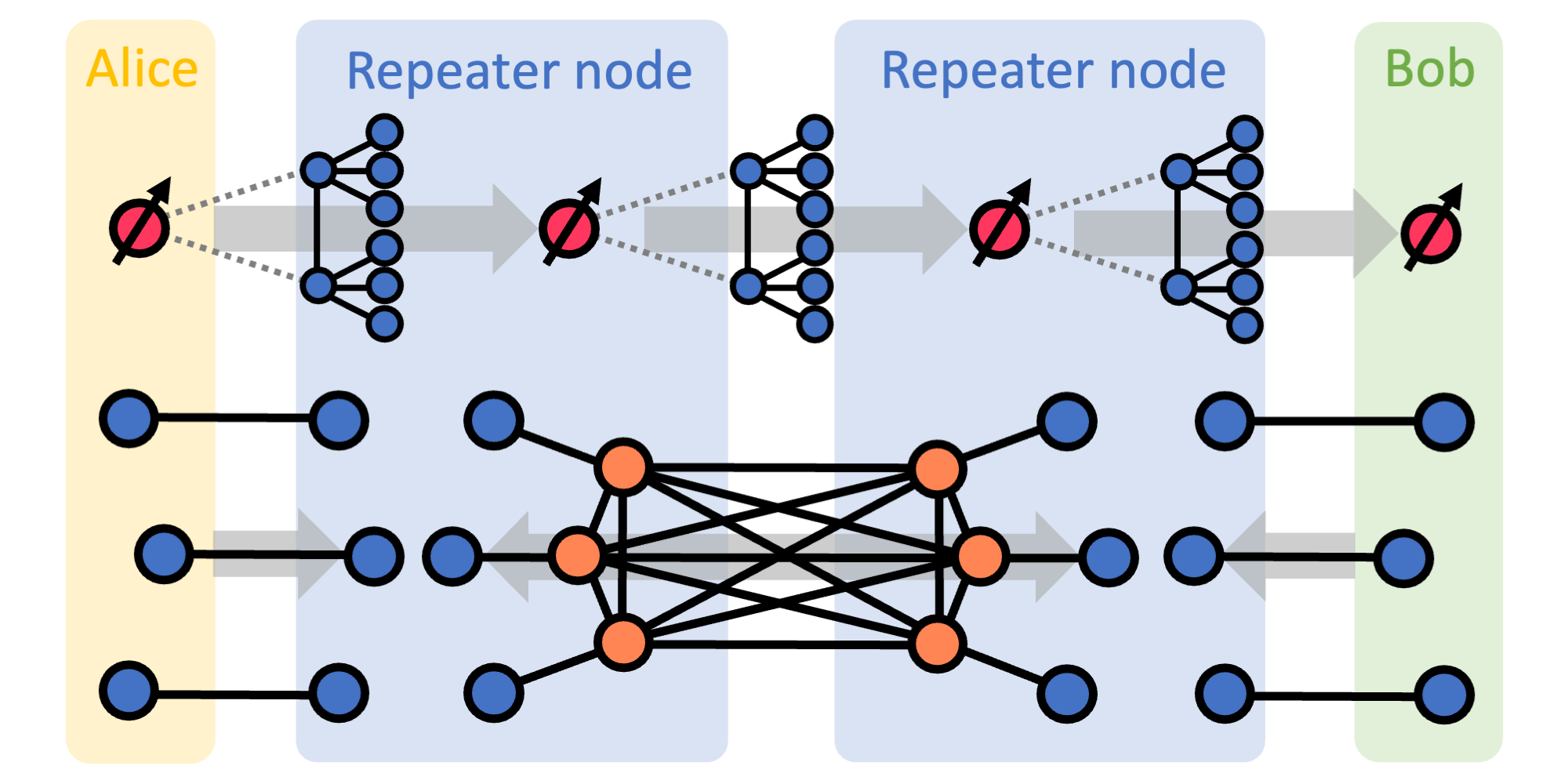
Featured image: Quantum repeaters based on photonic tree graph states and repeater graph states.
Popular summary
► BibTeX data
► References
[1] H. J. Kimble, The quantum internet, Nature 453 (7198) (2008) 1023–1030. doi:10.1038/nature07127.
https://doi.org/10.1038/nature07127
[2] T. E. Northup, R. Blatt, Quantum information transfer using photons, Nature Photonics 8 (5) (2014) 356–363. doi:10.1038/nphoton.2014.53.
https://doi.org/10.1038/nphoton.2014.53
[3] S. Wehner, D. Elkouss, R. Hanson, Quantum internet: A vision for the road ahead, Science 362 (6412) (2018) eaam9288. doi:10.1126/science.aam9288.
https://doi.org/10.1126/science.aam9288
[4] H.-J. Briegel, W. Dür, J. I. Cirac, P. Zoller, Quantum repeaters: The role of imperfect local operations in quantum communication, Phys. Rev. Lett. 81 (1998) 5932–5935. doi:10.1103/PhysRevLett.81.5932.
https://doi.org/10.1103/PhysRevLett.81.5932
[5] L. M. Duan, M. D. Lukin, J. I. Cirac, P. Zoller, Long-distance quantum communication with atomic ensembles and linear optics, Nature 414 (6862) (2001) 413–418. doi:10.1038/35106500.
https://doi.org/10.1038/35106500
[6] N. Sangouard, C. Simon, H. de Riedmatten, N. Gisin, Quantum repeaters based on atomic ensembles and linear optics, Rev. Mod. Phys. 83 (2011) 33–80. doi:10.1103/RevModPhys.83.33.
https://doi.org/10.1103/RevModPhys.83.33
[7] K. Azuma, K. Tamaki, H.-K. Lo, All-photonic quantum repeaters, Nature Communications 6 (1) (2015) 6787. doi:10.1038/ncomms7787.
https://doi.org/10.1038/ncomms7787
[8] J. Borregaard, H. Pichler, T. Schröder, M. D. Lukin, P. Lodahl, A. S. Sørensen, One-way quantum repeater based on near-deterministic photon-emitter interfaces, Phys. Rev. X 10 (2020) 021071. doi:10.1103/PhysRevX.10.021071.
https://doi.org/10.1103/PhysRevX.10.021071
[9] P. Hilaire, E. Barnes, S. E. Economou, F. Grosshans, Error-correcting entanglement swapping using a practical logical photon encoding, Phys. Rev. A 104 (2021) 052623. doi:10.1103/PhysRevA.104.052623.
https://doi.org/10.1103/PhysRevA.104.052623
[10] R. Zhang, L.-Z. Liu, Z.-D. Li, Y.-Y. Fei, X.-F. Yin, L. Li, N.-L. Liu, Y. Mao, Y.-A. Chen, J.-W. Pan, Loss-tolerant all-photonic quantum repeater with generalized shor code, Optica 9 (2) (2022) 152–158. doi:10.1364/OPTICA.439170.
https://doi.org/10.1364/OPTICA.439170
[11] P. Hilaire, E. Barnes, S. E. Economou, Resource requirements for efficient quantum communication using all-photonic graph states generated from a few matter qubits, Quantum 5 (2021) 397. doi:10.22331/q-2021-02-15-397.
https://doi.org/10.22331/q-2021-02-15-397
[12] Y. Li, P. C. Humphreys, G. J. Mendoza, S. C. Benjamin, Resource costs for fault-tolerant linear optical quantum computing, Phys. Rev. X 5 (2015) 041007. doi:10.1103/PhysRevX.5.041007.
https://doi.org/10.1103/PhysRevX.5.041007
[13] M. Pant, H. Krovi, D. Englund, S. Guha, Rate-distance tradeoff and resource costs for all-optical quantum repeaters, Phys. Rev. A 95 (2017) 012304. doi:10.1103/PhysRevA.95.012304.
https://doi.org/10.1103/PhysRevA.95.012304
[14] N. H. Lindner, T. Rudolph, Proposal for pulsed on-demand sources of photonic cluster state strings, Phys. Rev. Lett. 103 (2009) 113602. doi:10.1103/PhysRevLett.103.113602.
https://doi.org/10.1103/PhysRevLett.103.113602
[15] S. E. Economou, N. Lindner, T. Rudolph, Optically generated 2-dimensional photonic cluster state from coupled quantum dots, Phys. Rev. Lett. 105 (2010) 093601. doi:10.1103/PhysRevLett.105.093601.
https://doi.org/10.1103/PhysRevLett.105.093601
[16] H. Pichler, S. Choi, P. Zoller, M. D. Lukin, Universal photonic quantum computation via time-delayed feedback, Proceedings of the National Academy of Sciences 114 (43) (2017) 11362–11367. doi:10.1073/pnas.1711003114.
https://doi.org/10.1073/pnas.1711003114
[17] D. Buterakos, E. Barnes, S. E. Economou, Deterministic generation of all-photonic quantum repeaters from solid-state emitters, Phys. Rev. X 7 (2017) 041023. doi:10.1103/PhysRevX.7.041023.
https://doi.org/10.1103/PhysRevX.7.041023
[18] Y. Zhan, S. Sun, Deterministic generation of loss-tolerant photonic cluster states with a single quantum emitter, Phys. Rev. Lett. 125 (2020) 223601. doi:10.1103/PhysRevLett.125.223601.
https://doi.org/10.1103/PhysRevLett.125.223601
[19] Y. Shi, E. Waks, Deterministic generation of multidimensional photonic cluster states using time-delay feedback, Phys. Rev. A 104 (2021) 013703. doi:10.1103/PhysRevA.104.013703.
https://doi.org/10.1103/PhysRevA.104.013703
[20] C. P. Michaels, J. Arjona Martínez, R. Debroux, R. A. Parker, A. M. Stramma, L. I. Huber, C. M. Purser, M. Atatüre, D. A. Gangloff, Multidimensional cluster states using a single spin-photon interface coupled strongly to an intrinsic nuclear register, Quantum 5 (2021) 565. doi:10.22331/q-2021-10-19-565.
https://doi.org/10.22331/q-2021-10-19-565
[21] K. Wan, S. Choi, I. H. Kim, N. Shutty, P. Hayden, Fault-tolerant qubit from a constant number of components, PRX Quantum 2 (2021) 040345. doi:10.1103/PRXQuantum.2.040345.
https://doi.org/10.1103/PRXQuantum.2.040345
[22] B. Li, S. E. Economou, E. Barnes, Photonic resource state generation from a minimal number of quantum emitters, npj Quantum Information 8 (1) (2022) 11. doi:10.1038/s41534-022-00522-6.
https://doi.org/10.1038/s41534-022-00522-6
[23] H. Shapourian, A. Shabani, Modular architectures to deterministically generate graph states (2022). arXiv:2206.11307.
arXiv:2206.11307
[24] C. Schön, E. Solano, F. Verstraete, J. I. Cirac, M. M. Wolf, Sequential generation of entangled multiqubit states, Phys. Rev. Lett. 95 (2005) 110503. doi:10.1103/PhysRevLett.95.110503.
https://doi.org/10.1103/PhysRevLett.95.110503
[25] I. Schwartz, D. Cogan, E. R. Schmidgall, Y. Don, L. Gantz, O. Kenneth, N. H. Lindner, D. Gershoni, Deterministic generation of a cluster state of entangled photons, Science 354 (6311) (2016) 434–437. doi:10.1126/science.aah4758.
https://doi.org/10.1126/science.aah4758
[26] P. Thomas, L. Ruscio, O. Morin, G. Rempe, Efficient generation of entangled multiphoton graph states from a single atom, Nature 608 (7924) (2022) 677–681. doi:10.1038/s41586-022-04987-5.
https://doi.org/10.1038/s41586-022-04987-5
[27] M. Varnava, D. E. Browne, T. Rudolph, Loss tolerance in one-way quantum computation via counterfactual error correction, Phys. Rev. Lett. 97 (2006) 120501. doi:10.1103/PhysRevLett.97.120501.
https://doi.org/10.1103/PhysRevLett.97.120501
[28] S. Muralidharan, L. Li, J. Kim, N. Lütkenhaus, M. D. Lukin, L. Jiang, Optimal architectures for long distance quantum communication, Scientific Reports 6 (1) (2016) 20463. doi:10.1038/srep20463.
https://doi.org/10.1038/srep20463
[29] E. Waks, J. Vuckovic, Dipole induced transparency in drop-filter cavity-waveguide systems, Phys. Rev. Lett. 96 (2006) 153601. doi:10.1103/PhysRevLett.96.153601.
https://doi.org/10.1103/PhysRevLett.96.153601
[30] S. Fan, Ş. Kocabaş, J.-T. Shen, Input-output formalism for few-photon transport in one-dimensional nanophotonic waveguides coupled to a qubit, Physical Review A 82 (6) (2010) 063821–. doi:10.1103/PhysRevA.82.063821.
https://doi.org/10.1103/PhysRevA.82.063821
[31] V. Scarani, H. Bechmann-Pasquinucci, N. J. Cerf, M. Dušek, N. Lütkenhaus, M. Peev, The security of practical quantum key distribution, Rev. Mod. Phys. 81 (2009) 1301–1350. doi:10.1103/RevModPhys.81.1301.
https://doi.org/10.1103/RevModPhys.81.1301
[32] D. Bruß, Optimal eavesdropping in quantum cryptography with six states, Phys. Rev. Lett. 81 (1998) 3018–3021. doi:10.1103/PhysRevLett.81.3018.
https://doi.org/10.1103/PhysRevLett.81.3018
[33] H.-K. Lo, Proof of unconditional security of six-state quatum key distribution scheme, Quantum Info. Comput. 1 (2) (2001) 81–94.
[34] D. Najer, I. Söllner, P. Sekatski, V. Dolique, M. C. Löbl, D. Riedel, R. Schott, S. Starosielec, S. R. Valentin, A. D. Wieck, N. Sangouard, A. Ludwig, R. J. Warburton, A gated quantum dot strongly coupled to an optical microcavity, Nature 575 (7784) (2019) 622–627. doi:10.1038/s41586-019-1709-y.
https://doi.org/10.1038/s41586-019-1709-y
[35] M. K. Bhaskar, R. Riedinger, B. Machielse, D. S. Levonian, C. T. Nguyen, E. N. Knall, H. Park, D. Englund, M. Lončar, D. D. Sukachev, M. D. Lukin, Experimental demonstration of memory-enhanced quantum communication, Nature 580 (7801) (2020) 60–64. doi:10.1038/s41586-020-2103-5.
https://doi.org/10.1038/s41586-020-2103-5
[36] J. M. Kindem, A. Ruskuc, J. G. Bartholomew, J. Rochman, Y. Q. Huan, A. Faraon, Control and single-shot readout of an ion embedded in a nanophotonic cavity, Nature 580 (7802) (2020) 201–204. doi:10.1038/s41586-020-2160-9.
https://doi.org/10.1038/s41586-020-2160-9
[37] M. Raha, S. Chen, C. M. Phenicie, S. Ourari, A. M. Dibos, J. D. Thompson, Optical quantum nondemolition measurement of a single rare earth ion qubit, Nature Communications 11 (1) (2020) 1605. doi:10.1038/s41467-020-15138-7.
https://doi.org/10.1038/s41467-020-15138-7
[38] T. G. Tiecke, K. P. Nayak, J. D. Thompson, T. Peyronel, N. P. de Leon, V. Vuletić, M. D. Lukin, Efficient fiber-optical interface for nanophotonic devices, Optica 2 (2) (2015) 70–75. doi:10.1364/OPTICA.2.000070.
https://doi.org/10.1364/OPTICA.2.000070
[39] D. Press, T. D. Ladd, B. Zhang, Y. Yamamoto, Complete quantum control of a single quantum dot spin using ultrafast optical pulses, Nature 456 (7219) (2008) 218–221. doi:10.1038/nature07530.
https://doi.org/10.1038/nature07530
[40] K. De Greve, P. L. McMahon, D. Press, T. D. Ladd, D. Bisping, C. Schneider, M. Kamp, L. Worschech, S. Höfling, A. Forchel, Y. Yamamoto, Ultrafast coherent control and suppressed nuclear feedback of a single quantum dot hole qubit, Nature Physics 7 (11) (2011) 872–878. doi:10.1038/nphys2078.
https://doi.org/10.1038/nphys2078
[41] L. C. Bassett, F. J. Heremans, D. J. Christle, C. G. Yale, G. Burkard, B. B. Buckley, D. D. Awschalom, Ultrafast optical control of orbital and spin dynamics in a solid-state defect, Science 345 (6202) (2014) 1333–1337. doi:10.1126/science.1255541.
https://doi.org/10.1126/science.1255541
[42] J. N. Becker, J. Görlitz, C. Arend, M. Markham, C. Becher, Ultrafast all-optical coherent control of single silicon vacancy colour centres in diamond, Nature Communications 7 (1) (2016) 13512. doi:10.1038/ncomms13512.
https://doi.org/10.1038/ncomms13512
[43] M. V. G. Dutt, L. Childress, L. Jiang, E. Togan, J. Maze, F. Jelezko, A. S. Zibrov, P. R. Hemmer, M. D. Lukin, Quantum register based on individual electronic and nuclear spin qubits in diamond, Science 316 (5829) (2007) 1312–1316. doi:10.1126/science.1139831.
https://doi.org/10.1126/science.1139831
[44] W. Pfaff, T. H. Taminiau, L. Robledo, H. Bernien, M. Markham, D. J. Twitchen, R. Hanson, Demonstration of entanglement-by-measurement of solid-state qubits, Nature Physics 9 (1) (2013) 29–33. doi:10.1038/nphys2444.
https://doi.org/10.1038/nphys2444
[45] C. T. Nguyen, D. D. Sukachev, M. K. Bhaskar, B. Machielse, D. S. Levonian, E. N. Knall, P. Stroganov, R. Riedinger, H. Park, M. Lončar, M. D. Lukin, Quantum network nodes based on diamond qubits with an efficient nanophotonic interface, Phys. Rev. Lett. 123 (2019) 183602. doi:10.1103/PhysRevLett.123.183602.
https://doi.org/10.1103/PhysRevLett.123.183602
[46] P.-J. Stas, Y. Q. Huan, B. Machielse, E. N. Knall, A. Suleymanzade, B. Pingault, M. Sutula, S. W. Ding, C. M. Knaut, D. R. Assumpcao, Y.-C. Wei, M. K. Bhaskar, R. Riedinger, D. D. Sukachev, H. Park, M. Lončar, D. S. Levonian, M. D. Lukin, Robust multi-qubit quantum network node with integrated error detection, Science 378 (6619) (2022) 557–560. doi:10.1126/science.add9771.
https://doi.org/10.1126/science.add9771
[47] X. Rong, J. Geng, F. Shi, Y. Liu, K. Xu, W. Ma, F. Kong, Z. Jiang, Y. Wu, J. Du, Experimental fault-tolerant universal quantum gates with solid-state spins under ambient conditions, Nature Communications 6 (1) (2015) 8748. doi:10.1038/ncomms9748.
https://doi.org/10.1038/ncomms9748
[48] A. Gaëtan, Y. Miroshnychenko, T. Wilk, A. Chotia, M. Viteau, D. Comparat, P. Pillet, A. Browaeys, P. Grangier, Observation of collective excitation of two individual atoms in the rydberg blockade regime, Nature Physics 5 (2) (2009) 115–118. doi:10.1038/nphys1183.
https://doi.org/10.1038/nphys1183
[49] T. Wilk, A. Gaëtan, C. Evellin, J. Wolters, Y. Miroshnychenko, P. Grangier, A. Browaeys, Entanglement of two individual neutral atoms using rydberg blockade, Phys. Rev. Lett. 104 (2010) 010502. doi:10.1103/PhysRevLett.104.010502.
https://doi.org/10.1103/PhysRevLett.104.010502
[50] M. Arcari, I. Söllner, A. Javadi, S. Lindskov Hansen, S. Mahmoodian, J. Liu, H. Thyrrestrup, E. H. Lee, J. D. Song, S. Stobbe, P. Lodahl, Near-unity coupling efficiency of a quantum emitter to a photonic crystal waveguide, Phys. Rev. Lett. 113 (2014) 093603. doi:10.1103/PhysRevLett.113.093603.
https://doi.org/10.1103/PhysRevLett.113.093603
[51] Y. Ota, D. Takamiya, R. Ohta, H. Takagi, N. Kumagai, S. Iwamoto, Y. Arakawa, Large vacuum rabi splitting between a single quantum dot and an h0 photonic crystal nanocavity, Applied Physics Letters 112 (9) (2018) 093101. doi:10.1063/1.5016615.
https://doi.org/10.1063/1.5016615
[52] S. J. Roof, K. J. Kemp, M. D. Havey, I. M. Sokolov, Observation of single-photon superradiance and the cooperative lamb shift in an extended sample of cold atoms, Phys. Rev. Lett. 117 (2016) 073003. doi:10.1103/PhysRevLett.117.073003.
https://doi.org/10.1103/PhysRevLett.117.073003
[53] A. Reiserer, G. Rempe, Cavity-based quantum networks with single atoms and optical photons, Rev. Mod. Phys. 87 (2015) 1379–1418. doi:10.1103/RevModPhys.87.1379.
https://doi.org/10.1103/RevModPhys.87.1379
[54] G. Zhang, Y. Cheng, J.-P. Chou, A. Gali, Material platforms for defect qubits and single-photon emitters, Applied Physics Reviews 7 (3) (2020) 031308. doi:10.1063/5.0006075.
https://doi.org/10.1063/5.0006075
[55] C. E. Bradley, J. Randall, M. H. Abobeih, R. C. Berrevoets, M. J. Degen, M. A. Bakker, M. Markham, D. J. Twitchen, T. H. Taminiau, A ten-qubit solid-state spin register with quantum memory up to one minute, Phys. Rev. X 9 (2019) 031045. doi:10.1103/PhysRevX.9.031045.
https://doi.org/10.1103/PhysRevX.9.031045
[56] A. Ruskuc, C.-J. Wu, J. Rochman, J. Choi, A. Faraon, Nuclear spin-wave quantum register for a solid-state qubit, Nature 602 (7897) (2022) 408–413. doi:10.1038/s41586-021-04293-6.
https://doi.org/10.1038/s41586-021-04293-6
[57] F. Ewert, M. Bergmann, P. van Loock, Ultrafast long-distance quantum communication with static linear optics, Phys. Rev. Lett. 117 (2016) 210501. doi:10.1103/PhysRevLett.117.210501.
https://doi.org/10.1103/PhysRevLett.117.210501
[58] S.-W. Lee, T. C. Ralph, H. Jeong, Fundamental building block for all-optical scalable quantum networks, Phys. Rev. A 100 (2019) 052303. doi:10.1103/PhysRevA.100.052303.
https://doi.org/10.1103/PhysRevA.100.052303
[59] D. D. Sukachev, A. Sipahigil, C. T. Nguyen, M. K. Bhaskar, R. E. Evans, F. Jelezko, M. D. Lukin, Silicon-vacancy spin qubit in diamond: A quantum memory exceeding 10 ms with single-shot state readout, Phys. Rev. Lett. 119 (2017) 223602. doi:10.1103/PhysRevLett.119.223602.
https://doi.org/10.1103/PhysRevLett.119.223602
[60] L. Huthmacher, R. Stockill, E. Clarke, M. Hugues, C. Le Gall, M. Atatüre, Coherence of a dynamically decoupled quantum-dot hole spin, Phys. Rev. B 97 (2018) 241413. doi:10.1103/PhysRevB.97.241413.
https://doi.org/10.1103/PhysRevB.97.241413
[61] M. Brekenfeld, D. Niemietz, J. D. Christesen, G. Rempe, A quantum network node with crossed optical fibre cavities, Nature Physics 16 (6) (2020) 647–651. doi:10.1038/s41567-020-0855-3.
https://doi.org/10.1038/s41567-020-0855-3
[62] M. H. Abobeih, J. Cramer, M. A. Bakker, N. Kalb, M. Markham, D. J. Twitchen, T. H. Taminiau, One-second coherence for a single electron spin coupled to a multi-qubit nuclear-spin environment, Nature Communications 9 (1) (2018) 2552. doi:10.1038/s41467-018-04916-z.
https://doi.org/10.1038/s41467-018-04916-z
[63] D. Riedel, I. Söllner, B. J. Shields, S. Starosielec, P. Appel, E. Neu, P. Maletinsky, R. J. Warburton, Deterministic enhancement of coherent photon generation from a nitrogen-vacancy center in ultrapure diamond, Phys. Rev. X 7 (2017) 031040. doi:10.1103/PhysRevX.7.031040.
https://doi.org/10.1103/PhysRevX.7.031040
[64] T. Jung, J. Görlitz, B. Kambs, C. Pauly, N. Raatz, R. Nelz, E. Neu, A. M. Edmonds, M. Markham, F. Mücklich, J. Meijer, C. Becher, Spin measurements of nv centers coupled to a photonic crystal cavity, APL Photonics 4 (12) (2019) 120803. doi:10.1063/1.5120120.
https://doi.org/10.1063/1.5120120
Cited by
[1] Tom J. Bell, Love A. Pettersson, and Stefano Paesani, “Optimising graph codes for measurement-based loss tolerance”, arXiv:2212.04834, (2022).
The above citations are from SAO/NASA ADS (last updated successfully 2023-02-17 23:43:11). The list may be incomplete as not all publishers provide suitable and complete citation data.
On Crossref’s cited-by service no data on citing works was found (last attempt 2023-02-17 23:43:09).
This Paper is published in Quantum under the Creative Commons Attribution 4.0 International (CC BY 4.0) license. Copyright remains with the original copyright holders such as the authors or their institutions.
- SEO Powered Content & PR Distribution. Get Amplified Today.
- Platoblockchain. Web3 Metaverse Intelligence. Knowledge Amplified. Access Here.
- Source: https://quantum-journal.org/papers/q-2023-02-16-924/
- 1
- 10
- 100
- 11
- 1998
- 2001
- 2011
- 2014
- 2016
- 2017
- 2018
- 2019
- 2020
- 2021
- 2022
- 28
- 39
- 7
- 9
- a
- above
- ABSTRACT
- Academy
- access
- affiliations
- ahead
- All
- Although
- Ambient
- Ambient Conditions
- among
- analysis
- analyze
- and
- applied
- approach
- approaches
- approaching
- atom
- author
- authors
- based
- Bell
- Benjamin
- between
- Block
- Break
- Building
- cavities
- Center
- Centers
- challenge
- chen
- Cheng
- clear
- Cluster
- code
- COHERENT
- Collective
- Colorado
- comment
- Commons
- Communication
- Communications
- compare
- compared
- comparison
- complete
- components
- computation
- computing
- conditions
- constant
- control
- cooperative
- copyright
- Cost
- Costs
- coupled
- Crossed
- cryptography
- Crystal
- data
- degen
- Delayed
- Den
- Department
- Detection
- Determine
- developing
- Devices
- Diamond
- different
- discuss
- distance
- distribution
- DOT
- during
- dynamically
- dynamics
- earth
- Edwin
- efficiency
- efficient
- efficiently
- Electronic
- embedded
- enable
- enabled
- Environment
- error
- Ether (ETH)
- fan
- FAST
- feedback
- fei
- few
- formidable
- found
- from
- fundamental
- future
- gated
- Gates
- generate
- generated
- generation
- graph
- harvard
- help
- here
- holders
- Hole
- However
- HTTPS
- identify
- image
- in
- individual
- info
- information
- insights
- institutions
- integrated
- interesting
- Interface
- interfaces
- Intermediate
- International
- Internet
- intrinsic
- JavaScript
- journal
- Key
- Kim
- Kong
- large
- Last
- Lays
- Leave
- Lee
- License
- List
- local
- logical
- Long
- loss
- love
- major
- material
- Matter
- max-width
- measurements
- Memory
- Mendoza
- minimal
- minute
- modular
- Month
- more
- MS
- multiphoton
- multiple
- National
- Nature
- network
- networks
- Neutral
- New
- Nguyen
- node
- nodes
- nuclear
- number
- obstacles
- ONE
- open
- Operations
- optics
- optimal
- original
- PAN
- Paper
- parameter
- parameters
- Park
- Paul
- performance
- Photons
- physical
- Physics
- Platforms
- plato
- Plato Data Intelligence
- PlatoData
- potential
- Practical
- press
- Proceedings
- proof
- proposal
- proposed
- protocol
- protocols
- provide
- provides
- published
- publisher
- publishers
- Quantum
- quantum computing
- quantum cryptography
- Quantum dot
- Quantum dots
- quantum information
- Quantum Internet
- quantum networks
- Qubit
- qubits
- RARE
- Rates
- realize
- reduce
- references
- regime
- register
- remains
- Reports
- Requirements
- requires
- researchers
- resource
- Results
- review
- Reviews
- road
- robust
- Role
- roof
- scalable
- scheme
- schemes
- Science
- SCIENCES
- security
- selection
- shift
- significantly
- Silicon
- Simon
- single
- SIX
- Sources
- specific
- Spin
- spin qubits
- spins
- State
- States
- strongly
- Successfully
- such
- suitable
- Sun
- system
- Systems
- tech
- The
- the information
- their
- thompson
- Title
- to
- tolerance
- traditional
- transfer
- Transparency
- transport
- types
- unconditional
- under
- Universal
- university
- updated
- URL
- Vacuum
- Valuable
- various
- via
- virginia
- vision
- volume
- W
- Wolf
- Work
- works
- wu
- X
- year
- Yuan
- zephyrnet

